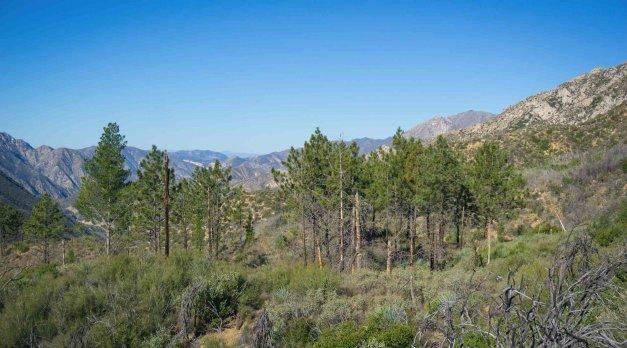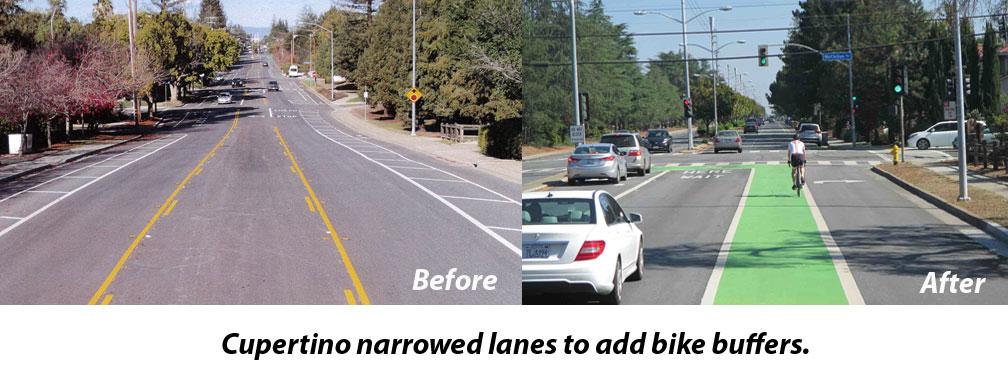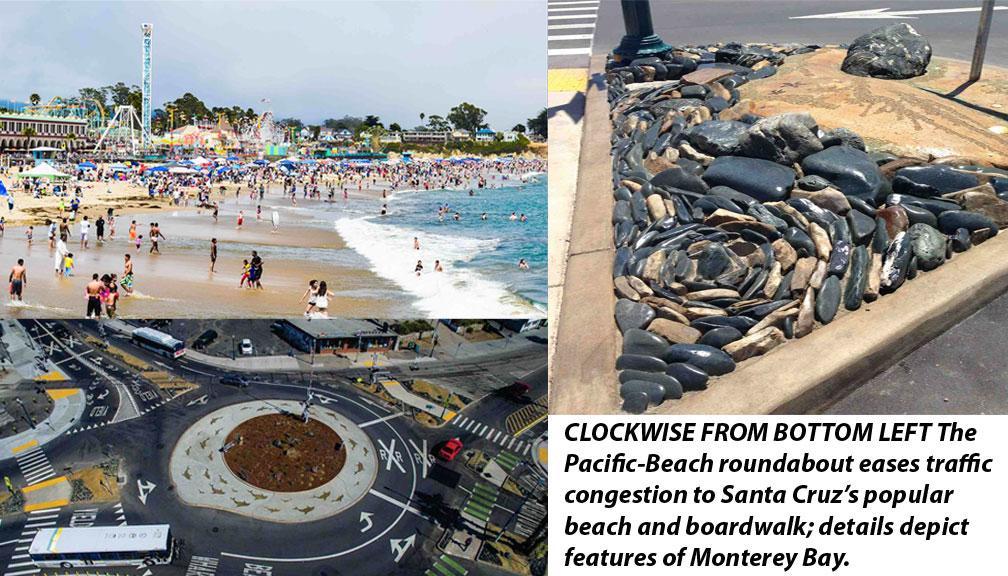Local Streets and Roads Awards Recognize Best Practices
Meghan McKelvey, department and member services manager for the League, and Eva Spiegel, director of communications for the League, contributed to this article. To learn more about the awards program, visit www.savecaliforniastreets.org.
The League, California State Association of Counties (CSAC) and County Engineers Association of California (CEAC) sponsor the annual Outstanding Local Streets and Roads Project Awards Program, which honors best practices in road projects that can be replicated by other jurisdictions. The awards, launched in 2014, also acknowledge cities and counties that promote fiscal and environmental sustainability in the local transportation system. The awards program committee announced the winners at the annual spring meeting of CEAC and the League’s Public Works Officers’ Institute in Sacramento in March 2016.
“Transportation funding is a major issue statewide,” said Matt Machado, Stanislaus County director of public works and CEAC president. “We’re recognizing these cities and counties for completing great projects that enhance safety, traffic flow and the environment at a time when funding is extremely tight.”
“It’s encouraging to see the Legislature debating how to create a stable statewide transportation funding plan. That process has included a focus on transparency and accountability, and that is exactly what these award-winning local projects exemplify,” said Culver City Public Works Director Charles Herbertson, chair of the Local Streets and Roads Awards Committee. “The winning counties, cities and finalists offer examples of how local governments are wisely investing taxpayer dollars in projects that improve the transportation system and better our communities.”
Category: Overall
Winner: Angeles Forest Highway Project, Los Angeles County
The Angeles Forest Highway Project, a joint effort of Los Angeles County and the Federal Highway Administration, showcases the benefits of properly applying a sustainable approach to road rehabilitation.
A scenic mountain route with access to hiking and equestrian trails, the Angeles Forest Highway provides the main connection between the Antelope Valley and the Los Angeles Basin. Sixteen and a half miles of its roadway were in poor condition with areas of severe structural deficiency that needed to be brought to current standards. The project used cold in-place recycling (CIR) to rehabilitate the roadway. Recycling the existing asphalt in place eliminated the need to remove pavement from the project location and import a conventional hot-mix asphalt to replace it. Using the CIR process reduced environmental impacts and road closures, shortened construction time and protected natural resources by mitigating the need to quarry tons of virgin aggregate materials.
Los Angeles County and the Federal Highway Administration shared the project’s cost, which totaled $4.3 million ($1.74 per square foot). Compared with a conventional hot-mix alternative, CIR saved approximately $2 million and extended the pavement’s service life by an estimated 10 years. It also provided substantial sustainability benefits by reducing energy consumption by 72 percent and greenhouse gas emissions by 74 percent and diverting 10,000 cubic yards of material from the landfill.
Contact: An Dang, associate civil engineer, Los Angeles County Department of Public Works; phone: (626) 458-7939; email: adang@dpw.lacounty.gov.
Category: Efficient and Sustainable Road and Bridge Preservation, Maintenance and Construction and Reconstruction Project
Winner: Cupertino Pavement Maintenance Program, City of Cupertino
Cupertino’s 139 centerline miles of street network include 103 miles of residential streets, 21 miles of collector streets (which move traffic from local streets to arterial roads) and 15 miles of arterial roads. The city manages its roads by proactively and routinely conducting asphalt maintenance projects to preserve the $340 million network.
A sustainable strategy, based upon consistent use of sustainable products and careful project coordination, helped Cupertino save time, money and natural resources and reduce inconveniences for residents and businesses. This effort also enabled the city to focus on enhancing active transportation (human-powered modes such as walking and cycling).
From fiscal year (FY) 2013–14 through FY 2015–16, Cupertino installed 4.8 miles of bike buffers and narrowed 5.6 lane miles to accommodate bike buffers, provide additional on-street parking and improve safety for all road users. The city projects that its street network Pavement Condition Index will increase to 80 by 2019.
Contact: Roger Lee, assistant director of public works, City of Cupertino; phone: (408) 777-3350; email: rogerl@cupertino.org.
Category: Complete Streets and Multimodal Mobility Project
Winner: Kings Beach Commercial Core Improvement Project, Placer County
Located along the north shore of Lake Tahoe in Placer County, the Kings Beach Commercial Core Improvement Project was a major public infrastructure investment that sought to revitalize the Kings Beach lakeshore community. The project features intermodal and roadway safety enhancements coupled with “complete streets” infrastructure and streetscape improvements.
An interesting aspect of the project involves stormwater treatment and erosion control. Stormwater is treated through sumps and vaults that allow larger pollutants to drop out, and seven sets of concrete chambers 15 feet deep and 12 feet in diameter use high-flow filters to help remove fine particulates and pollutants. Fine particulates are the prime cause of the diminished clarity of Lake Tahoe, which has been of great concern in recent decades, and these measures will help address the problem.
Wherever possible, the project used recycled materials, including concrete and pavers. In addition, the project incorporated pervious concrete to stabilize eroding road shoulders and minimize stormwater runoff from parking lots.
The Kings Beach project was designed to help trigger private redevelopment projects and provide multimodal benefits to increase and enhance transportation options in the community and beyond by creating enhanced public transit connectivity for the North Lake Tahoe region. The project also helps the community’s disadvantaged residents by providing improved and more affordable transportation options to education centers, health clinic services, family resource center services, employment guidance services and job locations.
Contact: Peter Kraatz, assistant director, Placer County Department of Public Works & Facilities; phone: (530) 581-6230; email: pkraatz@placer.ca.gov.
Category: Safety or Intelligent Transportation Systems Projects
Winner: Santa Cruz Beach Area Roundabouts, City of Santa Cruz
Pacific Avenue serves as a crucial link between downtown Santa Cruz and the beach area, which includes the boardwalk and municipal wharf. The city’s plan recommended constructing two roundabouts on Pacific Avenue, one at Center Street and the other at Beach Street. The intersection modifications improve traffic flow and bike and pedestrian access and safety. The modifications also support the city’s climate action goals to reduce transportation-related greenhouse gases. The roundabouts create a very attractive gateway to Monterey Bay and address multimodal safety and efficiency well into the future.
Both roundabouts feature depictions of ocean wildlife commonly found in Monterey Bay as well as unique operational characteristics. The Pacific-Center roundabout incorporates the main entrance to Depot Park, and the Pacific-Beach roundabout incorporates a railroad through the northern side, a cycle track (two-way bicycle facility) on the southern side and the entrance-exit gates to the Santa Cruz Municipal Wharf. The roundabouts eliminated the need for nine stop signs.
The project involved extensive public review and approval as well as agency cooperation and coordination efforts. Funding for the project came from a combination of federal stimulus funds, gasoline tax, Measure H Paving, developer fees, Utility Enterprise and General Capital Improvement Funds. The projects provided the city an opportunity to bring pavement, access ramps, sidewalks, lighting and storm drain, water and sewer facilities to current standards and capacity and address system preservation.
Contact: Christophe J. Schneiter, assistant director/city engineer, Department of Public Works, City of Santa Cruz; phone: (831) 420-5422; email: cschneiter@cityofsantacruz.com.
More Information Online
For more information about the award-winning projects and the finalists in each category, visit www.SaveCaliforniaStreets.org.
Photo credits: LA County, Kenkistler/Shutterstock.com (roadway); LA County, courtesy of Los Angeles County (roadway being repaired); City of Cupertino, courtesy of the City of Cupertino (both photos); Placer County, Joy Strotz/Shutterstock.com (photo on left with rock); Placer County, OLOS/Shutterstock.com (photo on right with trees); City of Santa Cruz, David Litman/Shutterstock.com (beach); City of Santa Cruz, courtesy of the City of Santa Cruz (roundabout and rocks)
This article appears in the July 2016 issue of Western City
Did you like what you read here? Subscribe
to Western City





